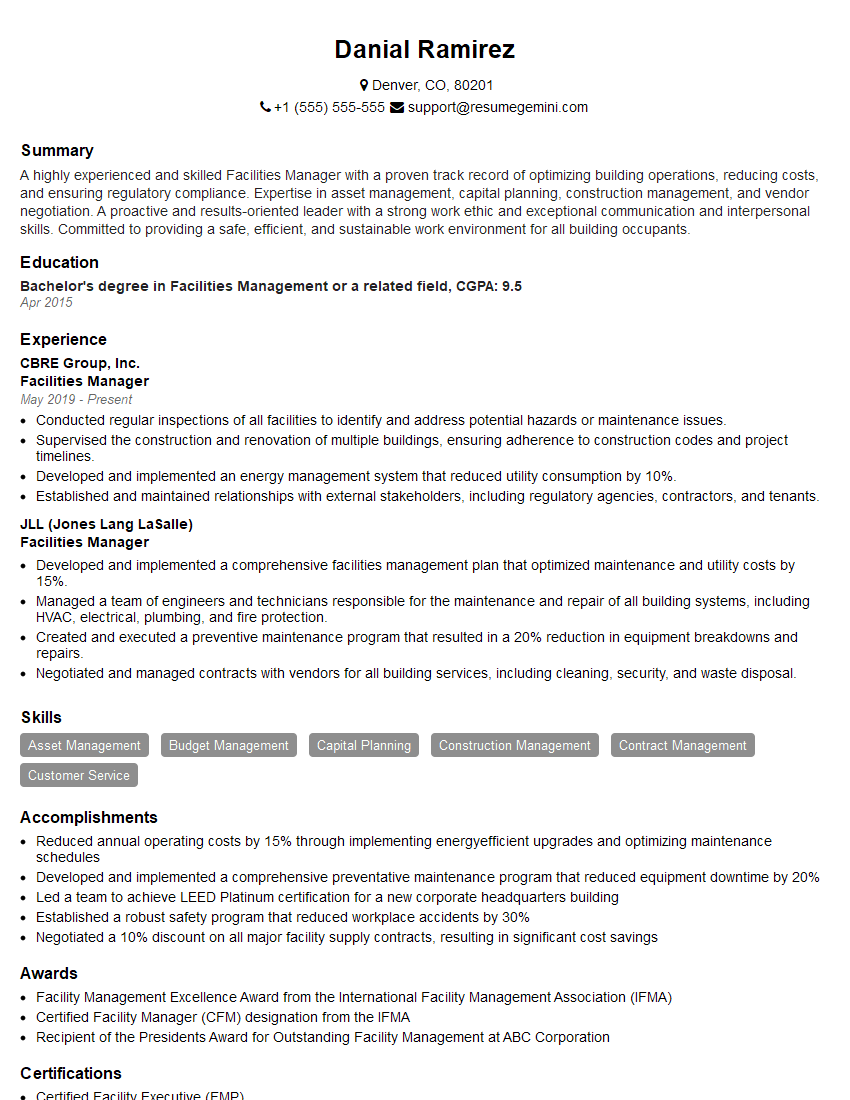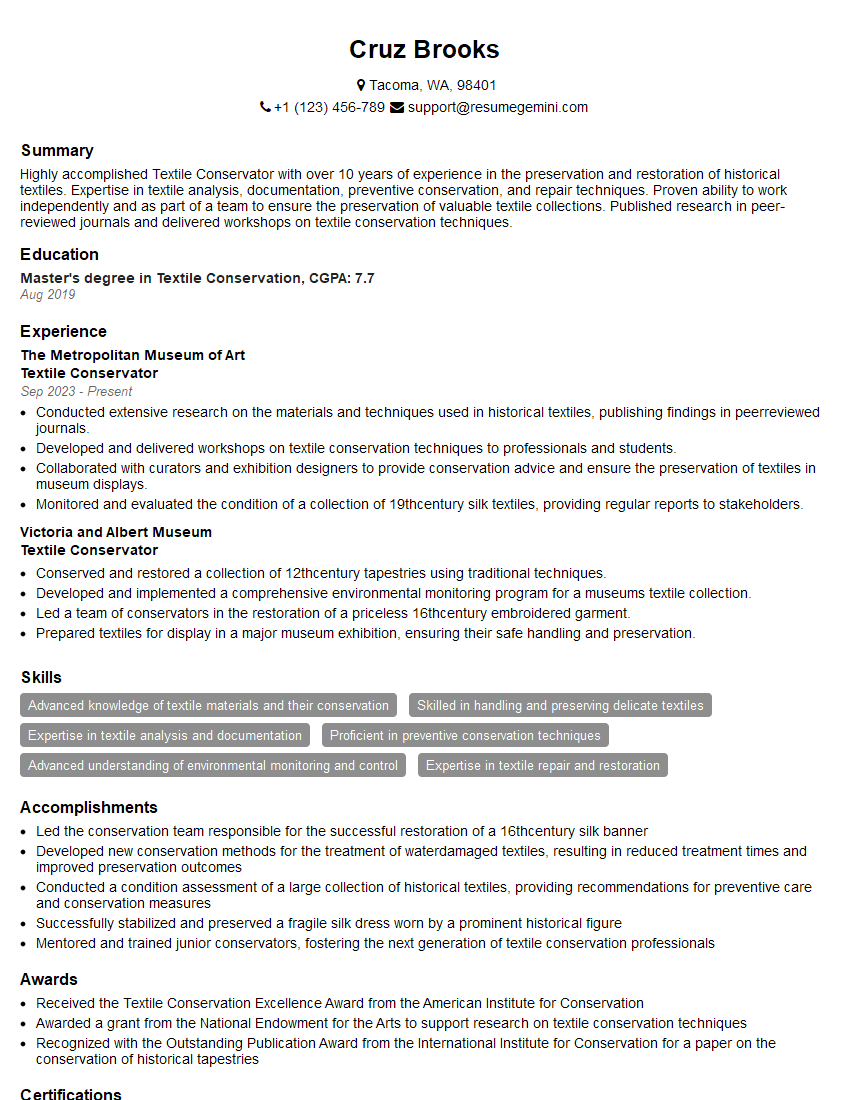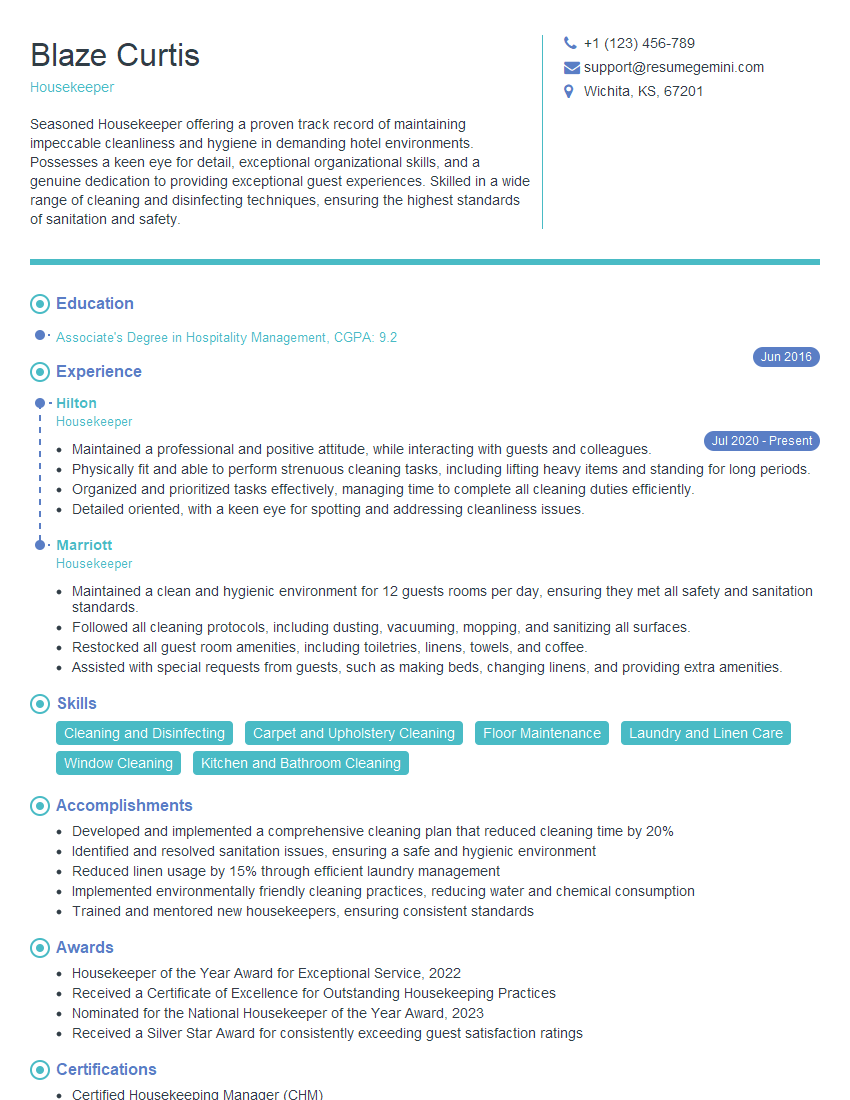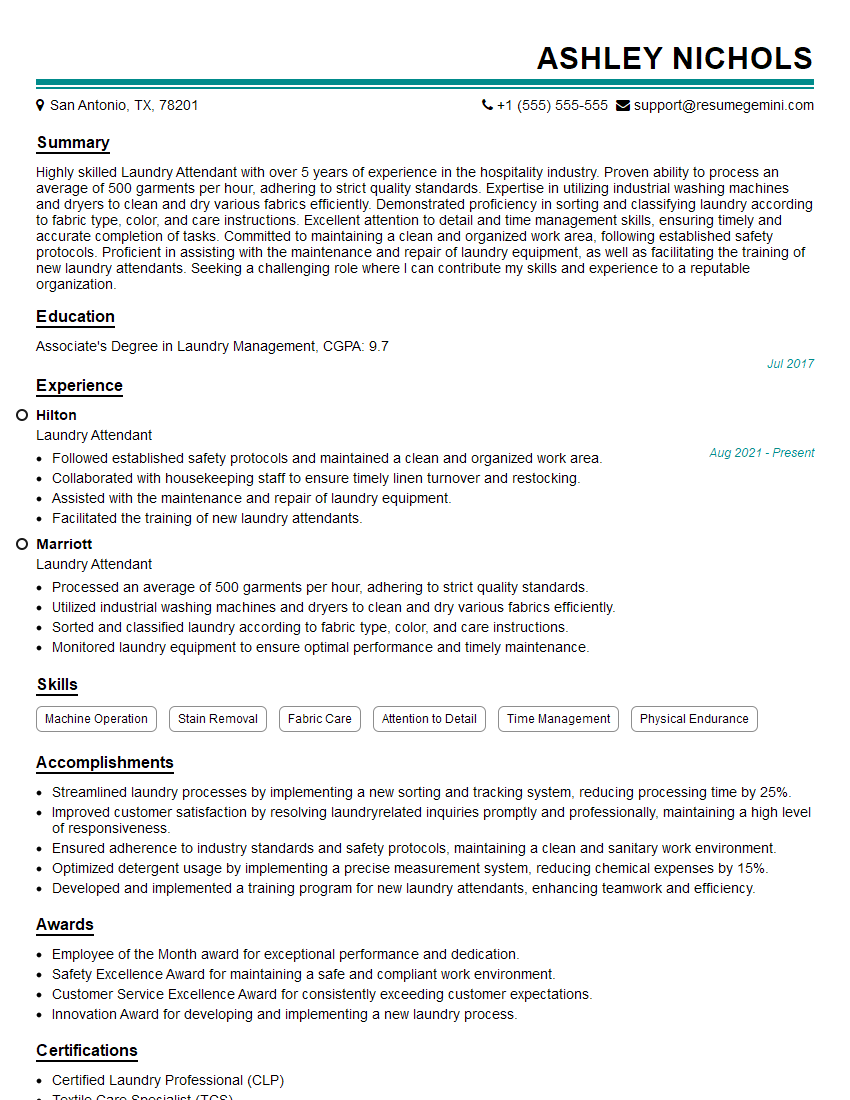Every successful interview starts with knowing what to expect. In this blog, we’ll take you through the top Spot and Stain Removal interview questions, breaking them down with expert tips to help you deliver impactful answers. Step into your next interview fully prepared and ready to succeed.
Questions Asked in Spot and Stain Removal Interview
Q 1. Explain the difference between water-based and solvent-based stain removers.
The core difference between water-based and solvent-based stain removers lies in their ability to dissolve various types of stains. Water-based removers are effective on water-soluble stains like juice, coffee, or blood. They work by dissolving the stain and allowing it to be rinsed away. Think of it like washing away a sugar spill with water – it dissolves and disappears. Solvent-based removers, on the other hand, tackle oil-based stains such as grease, oil, or lipstick. These removers contain solvents that break down the oily components of the stain, making them easier to remove. Imagine using dish soap to clean a greasy pan; the soap emulsifies the grease, separating it from the surface.
- Water-based removers: Generally gentler, suitable for most fabrics, readily available.
- Solvent-based removers: More powerful, effective on stubborn stains, may require pre-testing on an inconspicuous area, often stronger smelling.
Choosing the right type depends entirely on the nature of the stain. Using a solvent-based remover on a water-soluble stain is usually unnecessary and could potentially damage the fabric. Conversely, a water-based remover will be ineffective against grease.
Q 2. Describe your process for pre-treating a stain before cleaning.
Pre-treating a stain is crucial for successful removal, especially with stubborn or set-in stains. My process involves several key steps:
- Identify the stain: Knowing the type of stain (e.g., grease, blood, ink) dictates the appropriate pre-treatment method.
- Act quickly: Fresh stains are much easier to remove than older ones. The longer a stain sits, the more it sets into the fibers.
- Blot, don’t rub: Rubbing spreads the stain, pushing it deeper into the fabric. Always blot gently with a clean cloth or paper towel.
- Apply pre-treatment solution: Use a stain remover appropriate for the stain type. Apply a small amount directly to the stain and allow it to sit for the recommended time (usually 5-15 minutes).
- Test in an inconspicuous area: Before applying any solution to the visible stain, always test it on a hidden area of the fabric (e.g., inside a seam) to ensure it doesn’t cause discoloration or damage.
- Rinse thoroughly: After the recommended time, rinse the treated area with cool water to remove any remaining stain remover.
For example, a grease stain might be pre-treated with a solvent-based stain remover, while a blood stain might benefit from cold water and enzymatic cleaner.
Q 3. What are the common causes of water stains on fabric?
Water stains on fabric are typically caused by the minerals in hard water. These minerals leave behind deposits when the water evaporates, resulting in unsightly rings or discoloration. Other contributing factors include:
- Hard water: High mineral content in water leaves residue behind.
- Improper rinsing: Incomplete rinsing after washing can leave behind detergent or fabric softener residues, which can attract and trap minerals.
- Iron in water: Iron deposits can cause yellowish or brownish stains.
- Improper drying: Leaving wet clothes in a pile can cause water stains to set in.
The type of fabric also plays a role; some fabrics are more prone to water staining than others.
Q 4. How do you remove grease stains from upholstery?
Removing grease stains from upholstery requires a delicate approach. Aggressive scrubbing can damage the fabric and worsen the stain. Here’s my recommended process:
- Blot the excess grease: Use a clean cloth or paper towel to absorb as much grease as possible.
- Apply a grease-cutting dish soap solution: Mix a small amount of dish soap with cool water. Apply the solution to the stain using a soft sponge or cloth, blotting gently.
- Rinse thoroughly: Use a clean, damp cloth to rinse the area, blotting frequently to remove the soap residue.
- Dry completely: Allow the upholstery to air dry completely. Avoid using heat as this could set the stain.
- For stubborn stains: Consider using a solvent-based stain remover specifically designed for upholstery. Always test it on a hidden area first.
Remember to consult the upholstery’s cleaning instructions before attempting any stain removal. Some delicate materials may require professional cleaning.
Q 5. How do you remove ink stains from different fabrics?
Ink stain removal depends heavily on the type of ink (ballpoint, gel, fountain pen) and the fabric. There’s no one-size-fits-all solution.
- Ballpoint ink: Often responds well to rubbing alcohol or hand sanitizer. Apply a small amount to the stain, blot, and rinse.
- Gel ink: Can be more challenging. Try a stain remover specifically designed for ink. Sometimes, hairspray can help lift the ink, but test it first.
- Fountain pen ink: Often water-soluble, so blotting with cool water may suffice. However, stubborn stains might require a more aggressive approach.
Fabric considerations: Delicate fabrics like silk or wool require gentler methods, often professional cleaning. Always test any cleaning solution on an inconspicuous area first.
For example, a ballpoint ink stain on cotton can often be removed using rubbing alcohol, while a gel ink stain on silk may require professional dry cleaning.
Q 6. What is the best method for removing red wine stains?
Red wine stains are notorious, but acting fast is key. The longer it sits, the more difficult it becomes to remove. My approach involves:
- Immediate action: Blot the excess wine immediately with a clean cloth. Do not rub!
- Salt treatment: Cover the stain generously with salt. The salt helps to absorb the wine.
- Cold water rinse: After 15-20 minutes, rinse the area with cool water. Blot dry.
- Stain remover: If the stain persists, apply a stain remover specifically designed for red wine or use a mixture of white wine and water (this works surprisingly well). Rinse thoroughly.
- Professional cleaning: For delicate fabrics or stubborn stains, professional cleaning is recommended.
The salt method is effective because it acts as an absorbent, drawing the wine away from the fibers before it sets.
Q 7. How do you handle delicate fabrics requiring specialized stain removal techniques?
Delicate fabrics like silk, wool, lace, and cashmere require specialized techniques to avoid damage. The key is gentleness and careful consideration of the fabric’s properties.
- Avoid harsh chemicals: Strong detergents and solvents can damage delicate fibers. Opt for mild, pH-neutral cleaners.
- Hand washing: Hand washing in cool water is usually preferable to machine washing.
- Gentle agitation: Avoid vigorous scrubbing or wringing.
- Air drying: Lay the garment flat to air dry, away from direct sunlight or heat.
- Professional cleaning: For valuable or particularly delicate items, professional dry cleaning is always a safe option.
Before attempting any stain removal on delicate fabrics, consult the garment’s care label and consider testing your method in an inconspicuous area. When in doubt, professional cleaning is the safest route.
Q 8. Describe your experience with various types of stain removers (e.g., enzymatic, oxygen-based).
My experience with stain removers is extensive, encompassing a wide range of chemistries and applications. Enzymatic cleaners, for instance, are biological catalysts that break down protein-based stains like blood, grass, and pet messes. They’re gentle and effective, particularly on delicate fabrics. I’ve used many commercial brands, and I often tailor the application based on the stain’s age and the fabric type. Oxygen-based bleach, on the other hand, is a powerful oxidizing agent tackling a broader spectrum of stains, including those caused by wine, coffee, and tea. It’s crucial to note, however, that oxygen bleach can damage certain fabrics if not used correctly. I’ve also worked extensively with solvent-based stain removers for grease and oil, carefully selecting the solvent based on the fabric’s composition to avoid damage. The selection of the correct stain remover is always the first crucial step, a matter of understanding the stain’s chemical makeup and the fabric’s properties.
For example, I once treated a silk blouse stained with red wine using a delicate enzyme pre-treatment followed by gentle washing. The results were excellent, preventing permanent damage. In another case, I successfully removed a grease stain from a cotton shirt using a solvent-based cleaner, followed by laundering.
Q 9. How do you determine the appropriate cleaning method for different fabrics?
Determining the appropriate cleaning method for different fabrics is paramount to avoid damage. I always begin by identifying the fabric type (cotton, wool, silk, etc.) and checking the garment’s care label for specific instructions. The label often indicates whether dry cleaning or hand washing is recommended. Furthermore, I consider the stain’s nature and age. Fresh stains are much easier to remove than set-in stains. For delicate fabrics like silk or wool, I favor gentle hand washing or professional dry cleaning. For more robust fabrics like cotton or linen, I might use a machine wash with appropriate stain pre-treatment. The water temperature is also crucial; hot water can set stains and damage certain fabrics. I often test a cleaning method on an inconspicuous area first to ensure it doesn’t cause discoloration or damage.
For instance, a delicate wool sweater with a small coffee stain would be treated differently than a cotton shirt with mud. The sweater might require a spot treatment with a mild detergent solution and gentle blotting. The shirt, on the other hand, could be machine-washed with a heavy-duty detergent and stain remover. This careful assessment minimizes the risk of irreversible damage.
Q 10. How do you handle stubborn stains that resist initial treatment?
Stubborn stains require a more methodical approach. My strategy involves a multi-step process. First, I carefully examine the stain, attempting to identify its source. Then, I try different stain removal methods in a sequence, starting with the gentlest approach and gradually increasing in strength. For example, I might start with a simple solution of mild detergent and cold water, followed by a soak in oxygen bleach, and finally, if necessary, a solvent-based cleaner for grease or oil stains. Each step is followed by a thorough rinsing. I avoid harsh scrubbing, which can damage the fabric.
I also consider professional help for truly stubborn or unknown stains. A professional dry cleaner has access to specialized equipment and chemicals that can handle very difficult situations. I remember one instance where a deep-set red wine stain on a white tablecloth finally yielded to a combination of oxygen bleach, specialized enzymatic cleaner, and professional steam cleaning.
Q 11. Explain your understanding of colorfastness and its importance in stain removal.
Colorfastness refers to a fabric’s ability to retain its color when exposed to water, cleaning agents, or light. It’s crucial in stain removal because applying harsh chemicals or hot water to a non-colorfast fabric can cause bleeding or fading. Before starting any stain removal process, I always test for colorfastness on an inconspicuous area (usually an inside seam). This is done by applying a small amount of the cleaning solution and dabbing it gently with a clean cloth. If the color transfers to the cloth, the fabric is not colorfast, and I’ll need to use a gentler approach or seek professional cleaning.
Imagine trying to remove a stain from a brightly colored vintage shirt. A colorfastness test will help determine whether to use a powerful stain remover or stick with gentler alternatives to avoid ruining the vibrant hues of the garment.
Q 12. What safety precautions do you take when using chemical stain removers?
Safety is paramount when handling chemical stain removers. I always work in a well-ventilated area to avoid inhaling fumes. I wear appropriate protective gear, including gloves to protect my skin from irritation or burns, and eye protection to prevent accidental splashes. I carefully read and follow the manufacturer’s instructions on each product, paying close attention to dilution ratios and application methods. After using any chemical, I thoroughly wash my hands and dispose of the waste materials responsibly, according to local regulations.
For example, when working with chlorine bleach, proper ventilation and protective gloves are mandatory to avoid skin irritation and respiratory problems. Similarly, solvent-based cleaners should always be handled with care and adequate ventilation.
Q 13. How do you prevent color bleeding during stain removal?
Preventing color bleeding involves understanding colorfastness (as discussed previously) and using appropriate techniques. First, I always test for colorfastness. If the fabric is not colorfast, I’ll use cold water and a mild detergent or enzyme-based cleaner. I avoid using hot water, which can accelerate color bleeding. Instead of rubbing the stain, I gently blot it with a clean cloth to lift the stain without disturbing the dye. For stubborn stains on non-colorfast fabrics, I might consider professional dry cleaning, as they have specialized techniques and solutions that minimize color damage.
Consider a brightly colored silk scarf with a small grease stain. To avoid bleeding, I would use a gentle hand-wash with cool water and a mild detergent, delicately blotting the stain.
Q 14. Describe your experience with different cleaning equipment (e.g., steam cleaners, extraction machines).
My experience with cleaning equipment is significant. Steam cleaners are invaluable for loosening dirt and grime before stain treatment. The high-temperature steam helps to lift stains and sanitize fabrics. I find them particularly useful for upholstery and carpets. Extraction machines, also known as wet-dry vacuums, are excellent for removing moisture and cleaning solutions after stain treatment, leaving fabrics clean and dry. I’ve used both professional-grade and consumer-grade models of both types of equipment. The selection always depends on the job’s scope and the fabric’s sensitivity. For example, delicate fabrics would not be treated with high-pressure steam extraction.
In one instance, I used a steam cleaner to loosen dirt embedded in a woolen rug before applying a specialized rug cleaner. This combination resulted in the restoration of the rug’s vibrancy.
Q 15. How do you document your stain removal process?
Documenting the stain removal process is crucial for maintaining quality control and providing consistent service. My approach involves a detailed, multi-step system. First, I take a photograph of the stain before any treatment, noting the size, color, and type of fabric or surface. This serves as a baseline. Next, I document the cleaning agents used, their concentration, and the method of application (e.g., blotting, dabbing, spraying). I meticulously record the time spent on each stage, noting any changes in the stain’s appearance. Finally, I take a post-treatment photograph to demonstrate the result. This comprehensive documentation allows for tracking progress, improving techniques, and addressing potential issues effectively. It also serves as vital proof in case of any disputes. Think of it like a recipe for stain removal – the more details you include, the more reproducible the result.
Career Expert Tips:
- Ace those interviews! Prepare effectively by reviewing the Top 50 Most Common Interview Questions on ResumeGemini.
- Navigate your job search with confidence! Explore a wide range of Career Tips on ResumeGemini. Learn about common challenges and recommendations to overcome them.
- Craft the perfect resume! Master the Art of Resume Writing with ResumeGemini’s guide. Showcase your unique qualifications and achievements effectively.
- Don’t miss out on holiday savings! Build your dream resume with ResumeGemini’s ATS optimized templates.
Q 16. How do you handle customer complaints related to stain removal?
Handling customer complaints regarding stain removal requires a calm, professional approach. I begin by actively listening to the customer’s concerns, demonstrating empathy and understanding. I then carefully review my documentation from the cleaning process, comparing the before and after photos. If the stain wasn’t completely removed, or if new damage occurred, I analyze what went wrong. Was the cleaning agent appropriate for the fabric? Did I follow the correct procedure? I honestly explain my findings to the client, focusing on what steps were taken and why. If a solution is possible (e.g., re-treatment, partial refund), I offer it promptly. Excellent communication is key; keeping the customer informed and involved throughout the process helps build trust and manage expectations. For example, if a delicate silk garment shows unexpected damage, I’ll fully explain the reasons and possible solutions, emphasizing transparency over defensiveness.
Q 17. What are the different types of fibers and their sensitivity to various cleaning methods?
Different fibers react uniquely to various cleaning methods. Understanding these differences is paramount for successful stain removal. For example:
- Cotton: Relatively durable, tolerates most cleaning methods. However, high heat can cause shrinkage.
- Wool: Delicate fiber; requires gentle cleaning methods and cool water to avoid felting (matting of fibers).
- Silk: Very delicate; needs specialized cleaning agents and gentle handling. Dry cleaning is often preferred.
- Polyester: Durable synthetic fiber; usually handles various cleaning agents well, but high heat can damage it.
- Nylon: Similar to polyester; strong and usually responds well to cleaning, but avoid harsh chemicals.
Q 18. Describe your experience with removing stains from various surfaces (e.g., carpets, upholstery, clothing).
My experience spans a broad range of surfaces. Carpet stain removal frequently involves pre-treating the stain with an enzyme cleaner for organic matter, followed by hot water extraction using a professional machine. Upholstery requires a more gentle approach, often using foam cleaning methods to avoid over-wetting. I’ve successfully removed wine stains from wool carpets using a combination of blotting, enzyme cleaner, and specialized solvents. On clothing, I’ve handled everything from grass stains on cotton children’s clothes (using a paste of baking soda and water) to grease stains on silk blouses (requiring professional dry cleaning methods). Each surface necessitates a tailored approach, considering its material, colorfastness, and the nature of the stain.
Q 19. Explain your understanding of the different types of stains (e.g., protein-based, oil-based).
Understanding stain types is crucial for effective removal.
- Protein-based stains (blood, milk, egg) respond well to enzyme-based cleaners that break down the protein molecules. These should be treated promptly to prevent setting.
- Oil-based stains (grease, oil, butter) require solvent-based cleaners to dissolve the oils. Often, pre-treating with a dish soap solution followed by a solvent can effectively remove these stains.
- Water-based stains (coffee, tea, juice) are often easier to remove, but prompt action is still recommended. Blotting and rinsing are usually sufficient.
- Dye-based stains (ink, dye transfer) can be tricky, requiring specialized stain removers or professional cleaning.
Q 20. What are the limitations of different stain removal techniques?
Every stain removal technique has limitations. For example, bleach, while effective on some stains, can damage delicate fabrics and cause discoloration. Solvent-based cleaners are powerful but can also damage certain fibers if used improperly. Heat can set some stains, while others are heat-sensitive. Over-wetting can cause water damage, especially on delicate fabrics or certain types of furniture. Abrasive scrubbing can damage fibers, leaving behind more damage than the original stain. The best approach always involves careful consideration of the stain type, the fabric’s composition, and the limitations of each technique.
Q 21. How do you assess the extent of damage before attempting stain removal?
Assessing the extent of damage before stain removal involves a thorough visual inspection. I consider several factors:
- Stain age and setting: Older, set-in stains are more challenging to remove.
- Stain size and penetration: A small surface stain is easier to address than a deeply penetrated stain.
- Fabric type and colorfastness: Delicate fabrics are more vulnerable to damage.
- Previous attempts at removal: Unsuccessful attempts may have further compromised the fabric.
Q 22. How do you maintain the quality and appearance of fabrics after stain removal?
Maintaining fabric quality after stain removal is crucial. It involves understanding the fabric’s composition and treating it accordingly. Aggressive cleaning can damage delicate fibers, causing shrinkage, color fading, or weakening of the material. My approach focuses on gentle yet effective methods.
- Pre-treatment is key: Before any cleaning solution touches the fabric, I always test it in an inconspicuous area. This prevents unexpected damage.
- Appropriate cleaning methods: Different fabrics require different approaches. Delicate silks and wools need hand-washing or specialized dry cleaning, while sturdy cottons might tolerate machine washing.
- Proper rinsing: Thorough rinsing is crucial to remove all traces of cleaning agents, which can leave behind residue that attracts future stains or damages fibers.
- Gentle drying: Air drying is always preferred whenever possible, especially for delicate fabrics. High heat from dryers can cause shrinkage or damage colors.
- Professional help when needed: For antique or valuable fabrics, I always recommend consulting a professional textile conservator. Their expertise ensures the best possible outcome.
For instance, I once treated a silk scarf with a stubborn wine stain. Instead of harsh chemicals, I used a gentle solution of cold water and mild detergent, dabbing gently rather than rubbing. Following this, I carefully rinsed it and allowed it to air dry flat, maintaining its pristine condition.
Q 23. What are your strategies for preventing future staining?
Preventing stains is far easier than removing them. My strategy is multi-pronged, focusing on proactive measures:
- Quick action: The faster a stain is addressed, the easier it is to remove. Fresh stains are significantly easier to treat than those that have set.
- Protective measures: Using placemats, coasters, and tablecloths can significantly reduce the risk of spills and staining.
- Regular cleaning: Regular cleaning prevents stains from setting deep into the fibers. This is particularly crucial for high-traffic areas or items subjected to frequent use.
- Pre-treating fabrics: Applying a fabric protector can create a barrier against spills and stains, making them easier to remove if they do occur.
- Appropriate storage: Storing items properly, away from dust and moisture, also contributes to longevity and stain prevention.
Think of it like preventative medicine – it’s much easier to prevent a problem than to cure it. A little foresight can save a lot of time and effort in the long run.
Q 24. Describe a time you had to deal with a particularly challenging stain. What was your approach?
One particularly challenging stain involved a vintage Persian rug with a large, embedded grease stain from a dropped candle. The grease had seeped deep into the wool fibers and had already begun to yellow. My approach was methodical:
- Assessment: I carefully examined the stain to determine its type and extent, noting the rug’s delicate nature.
- Testing: I tested various cleaning solutions on an inconspicuous area to find the safest and most effective approach.
- Gentle absorption: I started by using cornstarch to absorb excess grease. I gently applied it, letting it sit for several hours to draw out the stain.
- Specialized cleaning: I then used a gentle wool-safe cleaning solution applied with a soft brush, working from the outside of the stain inwards to avoid spreading it.
- Rinsing: I carefully rinsed the area using distilled water and a clean cloth, blotting gently to avoid damaging the fibers.
- Drying: Finally, I carefully blotted the area dry and allowed the rug to air dry completely, away from direct sunlight.
The key was patience and a gentle, systematic approach. It took several days of meticulous work, but the stain was successfully removed, preserving the rug’s beauty and value.
Q 25. What is your experience with using specialized equipment for stain removal?
My experience with specialized equipment encompasses a range of tools designed for efficient and safe stain removal. These include:
- Ultrasonic cleaners: Excellent for delicate items and jewelry, using sound waves to loosen embedded dirt and stains.
- Steam cleaners: Effective for removing stains from upholstery and carpets, using high-pressure steam to lift stains.
- Dry cleaning machines: For professional dry cleaning of garments, using specialized solvents.
- Stain removal pens: Handy for quick treatment of small, fresh stains on various fabrics.
Each piece of equipment requires specific training and careful handling to avoid damage to fabrics or injury to the user. For example, the temperature and pressure settings on a steam cleaner must be carefully adjusted to match the type of fabric being cleaned. Improper use can lead to damage, shrinking, or discoloration.
Q 26. What are your preferred methods for testing cleaning solutions on fabrics?
Testing cleaning solutions is a non-negotiable step in my process. I always test on an inconspicuous area first, hidden from view, such as an inside seam or a hidden area of the garment.
- Apply a small amount: Use a tiny amount of the cleaning solution, applying it to the hidden area of the fabric.
- Allow it to dry: Let the solution dry completely before inspecting for any discoloration, damage, or changes in the texture.
- Check for colorfastness: If using a colored fabric, check for bleeding or discoloration.
- Repeat if necessary: If the test area shows no adverse effects, proceed with the cleaning process. If discoloration or damage appears, select a different cleaning solution.
It’s like a trial run before the main event, ensuring the safety and effectiveness of the cleaning process, preventing potential damage to the fabric.
Q 27. How do you ensure the safety of the cleaning process for both the fabric and the environment?
Safety is paramount, encompassing both fabric and environmental considerations.
- Fabric safety: I prioritize using cleaning solutions appropriate for the fabric type. I always test solutions beforehand, avoiding harsh chemicals whenever possible and opting for natural and eco-friendly alternatives when feasible.
- Environmental safety: I choose cleaning products with minimal environmental impact. This includes selecting biodegradable and non-toxic options, and disposing of waste responsibly. I also prioritize methods that reduce water consumption, such as spot cleaning over full submersion when appropriate.
- Personal safety: Proper ventilation is essential when using any cleaning solutions, particularly those with strong odors. I always wear appropriate personal protective equipment (PPE) such as gloves to avoid skin irritation or chemical exposure.
In essence, my approach is to ensure a process that achieves excellent cleaning results while minimizing any negative impact on the environment and the health of those involved.
Key Topics to Learn for Spot and Stain Removal Interview
- Fabric Identification and Fiber Analysis: Understanding different fabric types (natural vs. synthetic, weave structures) and their impact on stain removal techniques.
- Stain Classification and Pre-Treatment: Categorizing stains (protein-based, oil-based, etc.) and applying appropriate pre-treatment methods before washing.
- Cleaning Agents and Their Applications: Knowing the properties of various cleaning agents (detergents, solvents, enzymes) and their suitability for different stain types and fabrics.
- Stain Removal Techniques: Mastering different techniques like blotting, flushing, brushing, and specialized methods for specific stains (e.g., blood, wine, grease).
- Colorfastness Testing: Understanding how to test for colorfastness to prevent damage during stain removal.
- Equipment and Technology: Familiarity with relevant equipment (washing machines, dry cleaning machines, specialized stain removal tools) and emerging technologies in the field.
- Safety Precautions and Handling of Chemicals: Understanding safe handling procedures for cleaning agents and proper disposal methods.
- Troubleshooting Common Issues: Identifying and resolving common problems encountered during stain removal, such as color bleeding or fabric damage.
- Sustainable Practices in Spot and Stain Removal: Understanding environmentally friendly cleaning methods and minimizing chemical waste.
Next Steps
Mastering spot and stain removal techniques is crucial for career advancement in various industries, from hospitality and healthcare to textile care and restoration. A strong understanding of these techniques showcases your attention to detail, problem-solving skills, and commitment to quality. To maximize your job prospects, create a compelling and ATS-friendly resume that highlights your skills and experience. ResumeGemini is a trusted resource to help you build a professional resume that truly stands out. Examples of resumes tailored to the Spot and Stain Removal field are available to guide you.
Explore more articles
Users Rating of Our Blogs
Share Your Experience
We value your feedback! Please rate our content and share your thoughts (optional).
What Readers Say About Our Blog
Hello,
We found issues with your domain’s email setup that may be sending your messages to spam or blocking them completely. InboxShield Mini shows you how to fix it in minutes — no tech skills required.
Scan your domain now for details: https://inboxshield-mini.com/
— Adam @ InboxShield Mini
Reply STOP to unsubscribe
Hi, are you owner of interviewgemini.com? What if I told you I could help you find extra time in your schedule, reconnect with leads you didn’t even realize you missed, and bring in more “I want to work with you” conversations, without increasing your ad spend or hiring a full-time employee?
All with a flexible, budget-friendly service that could easily pay for itself. Sounds good?
Would it be nice to jump on a quick 10-minute call so I can show you exactly how we make this work?
Best,
Hapei
Marketing Director
Hey, I know you’re the owner of interviewgemini.com. I’ll be quick.
Fundraising for your business is tough and time-consuming. We make it easier by guaranteeing two private investor meetings each month, for six months. No demos, no pitch events – just direct introductions to active investors matched to your startup.
If youR17;re raising, this could help you build real momentum. Want me to send more info?
Hi, I represent an SEO company that specialises in getting you AI citations and higher rankings on Google. I’d like to offer you a 100% free SEO audit for your website. Would you be interested?
Hi, I represent an SEO company that specialises in getting you AI citations and higher rankings on Google. I’d like to offer you a 100% free SEO audit for your website. Would you be interested?
good









